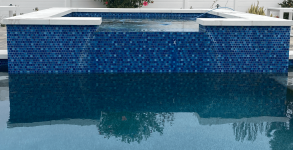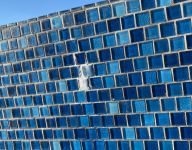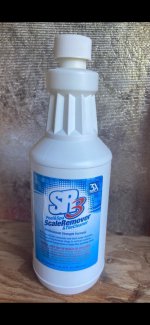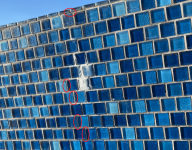- May 23, 2019
- 64
- Pool Size
- 17000
- Surface
- Plaster
- Chlorine
- Salt Water Generator
- SWG Type
- Pentair Intellichlor IC-40
Bear with me, this is a question with a few parts. I understand that the "proper" solution to some of those parts might be to rip something out and start again. While I respect that opinion, that's not feasible for me at the moment, so I would appreciate other options, even if they are not perfect. Thanks in advance for reading!
I have a spillover from my raised spa into the pool. As you can see in the picture, it has accumulated calcium buildup over time (almost four years since the original fill). My calcium is high; I plan to take care of that separately and have already reduced it from 1,200 ppm to 950 ppm with some strategic partial refills. In addition, there is one small spot (shown in the closeup photo) with a significant calcium buildup due to what appears to be a very slow leak coming through the grout. It took me a long time to suspect it is a leak; there is no obvious flow of water, it just stays damp to the touch. My theory is the water continually evaporates and leaves calcium behind. Due to some (probably over-aggressive) use of diluted muriatic acid and scrubbing to clean that main calcium patch, the grout around and below that area is thin and partially warn away.


With all this in mind, I have the following questions:
I have a spillover from my raised spa into the pool. As you can see in the picture, it has accumulated calcium buildup over time (almost four years since the original fill). My calcium is high; I plan to take care of that separately and have already reduced it from 1,200 ppm to 950 ppm with some strategic partial refills. In addition, there is one small spot (shown in the closeup photo) with a significant calcium buildup due to what appears to be a very slow leak coming through the grout. It took me a long time to suspect it is a leak; there is no obvious flow of water, it just stays damp to the touch. My theory is the water continually evaporates and leaves calcium behind. Due to some (probably over-aggressive) use of diluted muriatic acid and scrubbing to clean that main calcium patch, the grout around and below that area is thin and partially warn away.


With all this in mind, I have the following questions:
- I assume it is best to mostly or completely empty the spa behind the spillover wall before I attempt any repairs, is that correct?
- What is the best way to clean off the calcium buildup, bearing in mind I have glass tile? Assuming I will have to do some regrouting anyway (see below), is diluted muriatic acid an option?
- What, if anything, can I do to stop or slow down the leak? If I remove the grout in that area completely, is there anything I can add between the tiles before regrouting that will help?
- I have read that I can grout over the old grout where it has thinned as long as I make sure the existing grout is intact and clean. Does that sound right? I would prefer not to remove more grout than is necessary.
- The grout is TEC (color = #939 "mist") and it appears to be sanded. Any suggestions on the best product to use? My research seems to indicate TEC "Power Grout" is their best sanded product for pools (Stain Resistant & Efflorescence Free Grout). They sell an epoxy product but I don't think it would match the current grout and the installation sounds more difficult, so that's probably not a good idea for this repair.
- Any thoughts on how the leak is occurring? There is a pipe that runs inside that wall, but it is much lower than the spot that stays damp. My theory is that water is coming from the spa side of the wall or possibly the top due to imperfect waterproofing.



